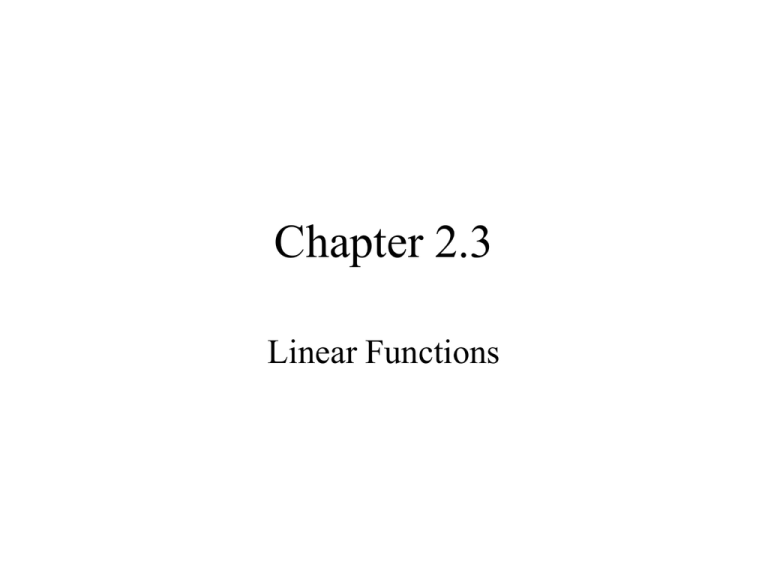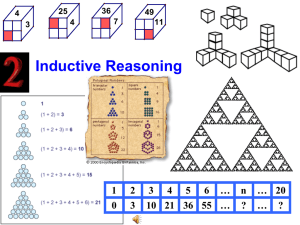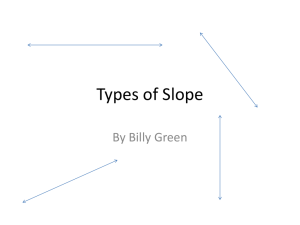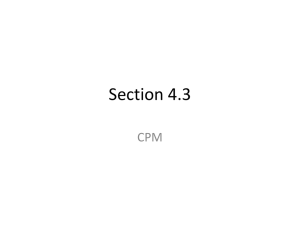2.3 Powerpoint
advertisement

Chapter 2.3 Linear Functions Graphing Linear Functions We begin our study of specific functions by looking at linear functions. The name “linear” comes from the fact that the graph of every linear function is a straight line. If a 0, thedomain and range of a linear functionare both - , . If a 0, then theequation becomes f(x) b. In thiscase, thedomain is (-, ) and therange is [b]. In Section 2.1, we graphed lines by finding ordered pairs and plotting them. Although only two points are necessary to graph a linear function, we usually plot a third point as a check. The intercepts are often good points to choose for graphing lines y Example 1 Graphing a Linear Function Using Intercepts Graph f(x) = -2x + 6 Give the domain and range. x y Example 2 Graphing a Horizontal Line Graph f(x) = -3 Give the domain and range. x y Example 3 Graphing a Vertical Line Graph x = -3 Give the domain and range. x Standard Form Ax + By = C Equations of lines are often written in the form Ax + By = C, called standard form. y Example 4 Graphing Ax + By = C with C = 0 Graph 4x + 5y = 0 Give the domain and range. x Slope An important characteristic of a straight line is its slope, a numerical measure of the steepness of a line. Geometrically, this may be interpreted as the ratio of rise to run. To find the slope of a line, start with two distinct points (x1, y1) and (x2, y2) on the line, as shown in Figure 25, where x1 ≠ x2. As we movealong theline from(x1 , y1 ) to (x2 , y 2 ) thehorizontaldifferencex 2 - x1 is called the changein x,denotedby x (read" delta x"), where is theGreek letterdelta. In thesame way, the verticaldifference y 2 - y1 called thechangein y, can be written y y 2 y1. T heslope of a nonvertical line is defined as thequotient(ratio)of thechangein y and thechangein x as follows. y Graph x=3 x y Example 5 Finding Slopes with the Slope Formula Find the slope of the line through the given points (-4,8) & (2,-3) x y Example 5 Finding Slopes with the Slope Formula Find the slope of the line through the given points (2,7) & (2,-4) x y Example 5 Finding Slopes with the Slope Formula Find the slope of the line through the given points (5,-3) & (-2,-3) x y Example 6 Finding the Slope from an Equation Find the slope of the line y = -4x - 3 x y Example 7 Finding a Line Using a Point and the Slope Graph the line passing through (-1, 5) and having a slope x 5 3 Example 8 Interpreting Slope as Average Rate of Change In 1997, sales of VCR’s numbered 16.7 million. In 2002, estimated sales of VCR’s were 13.3 million. Find the average rate of change in VCR sales, in millions per year. Linear Models In Example 8, we used the graph of a line to approximate real data. Recall from Section 1.2 this this is called mathematical modeling. Points on the straight line graph model (approximate) the actual points that correspond to the data. A linear cost function has the form C(x) = mx + b where x represents the number of items produced, m represents the variable cost per item, and b represents the fixed cost. The fixed cost is constant for a particular product and does not change as more items are made. The variable cost per item, which increases as more items are produced, covers labor, packaging, shipping and so on. The revenue function for selling a product depends on the price per item p and the number of items sold x, and is given by R(x) = px Profit is described by the profit function defined as P(x) = R(x) – C(x). Example 9 Writing Linear Cost, Revenue, and Profit Functions Assume that the cost to produce an item is a linear function and all items produced are sold. The fixed cost is $1500, the variable cost per item is $100, and item sells for $125. Write linear functions to model (a) (b) (c) (d) cost revenue profit How many items must be sold for the company to make a profit? Example 9 Writing Linear Cost, Revenue, and Profit Functions Revenue = R(x) = px = 125x Example 9 Writing Linear Cost, Revenue, and Profit Functions Cost = C(x) = mx + b 100x + 1500 Example 9 Writing Linear Cost, Revenue, and Profit Functions Profit = P(x) = R(x) – C(x) 125x –(100x – 1500) Example 9 Writing Linear Cost, Revenue, and Profit Functions To make a profit, P(x) must be positive. From part (c) P(x) = 25x - 1500 P(x) > 0 25x - 1500 > 0







